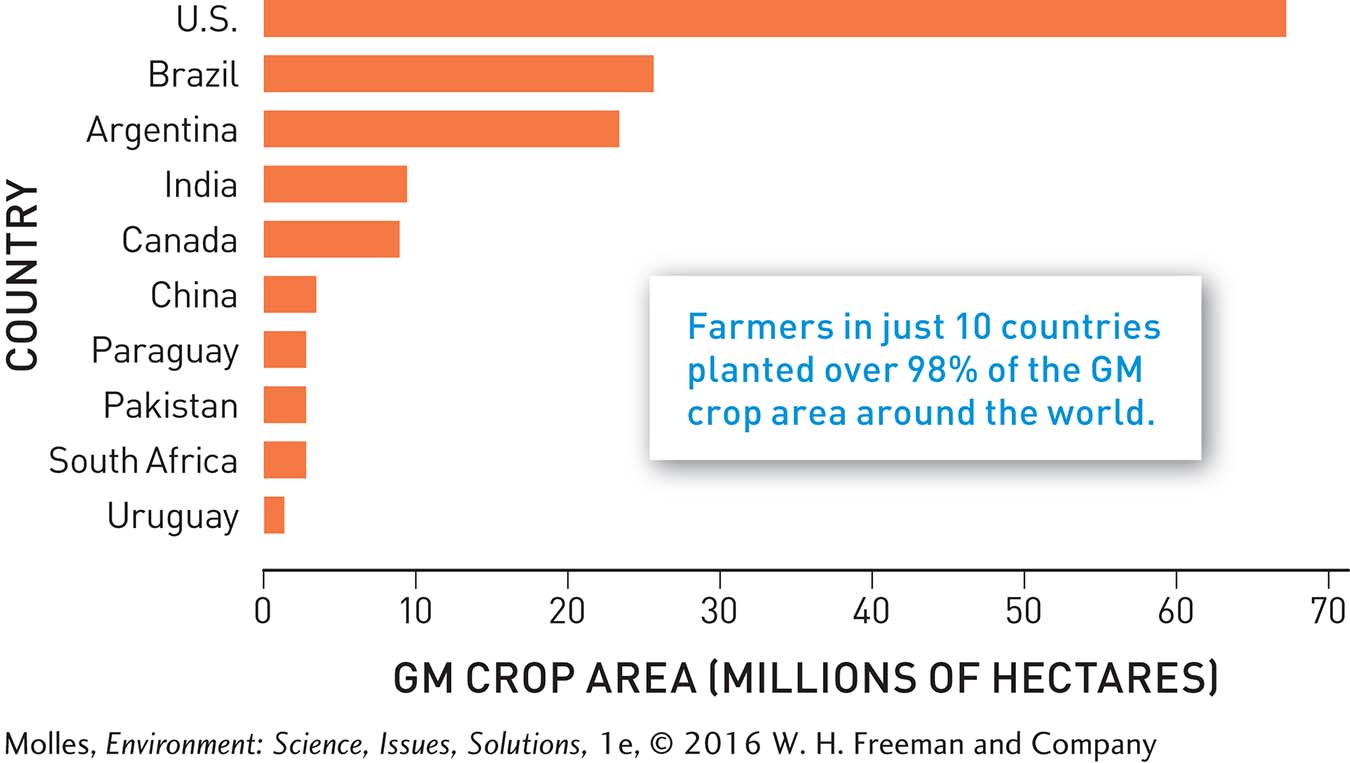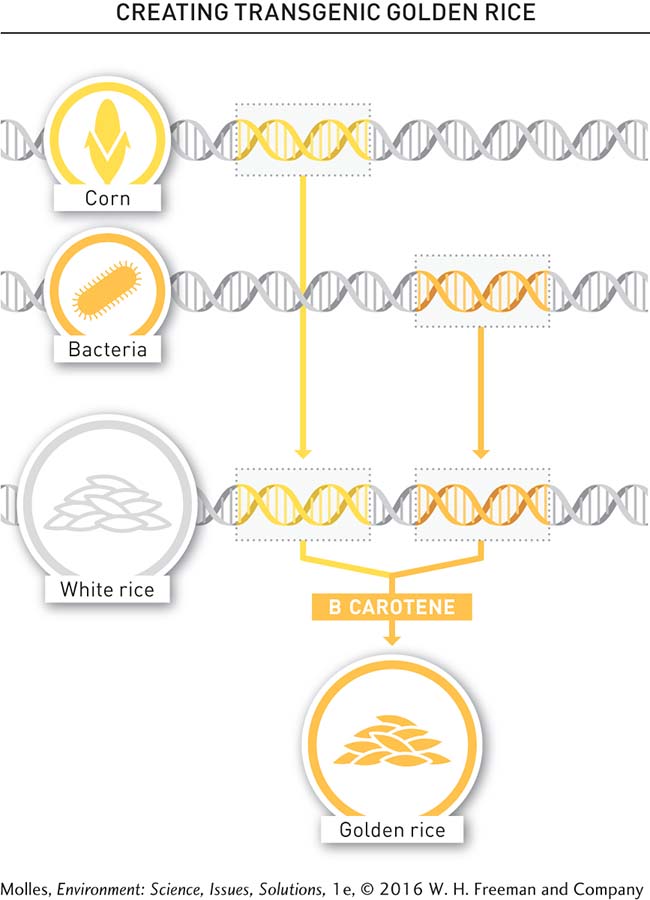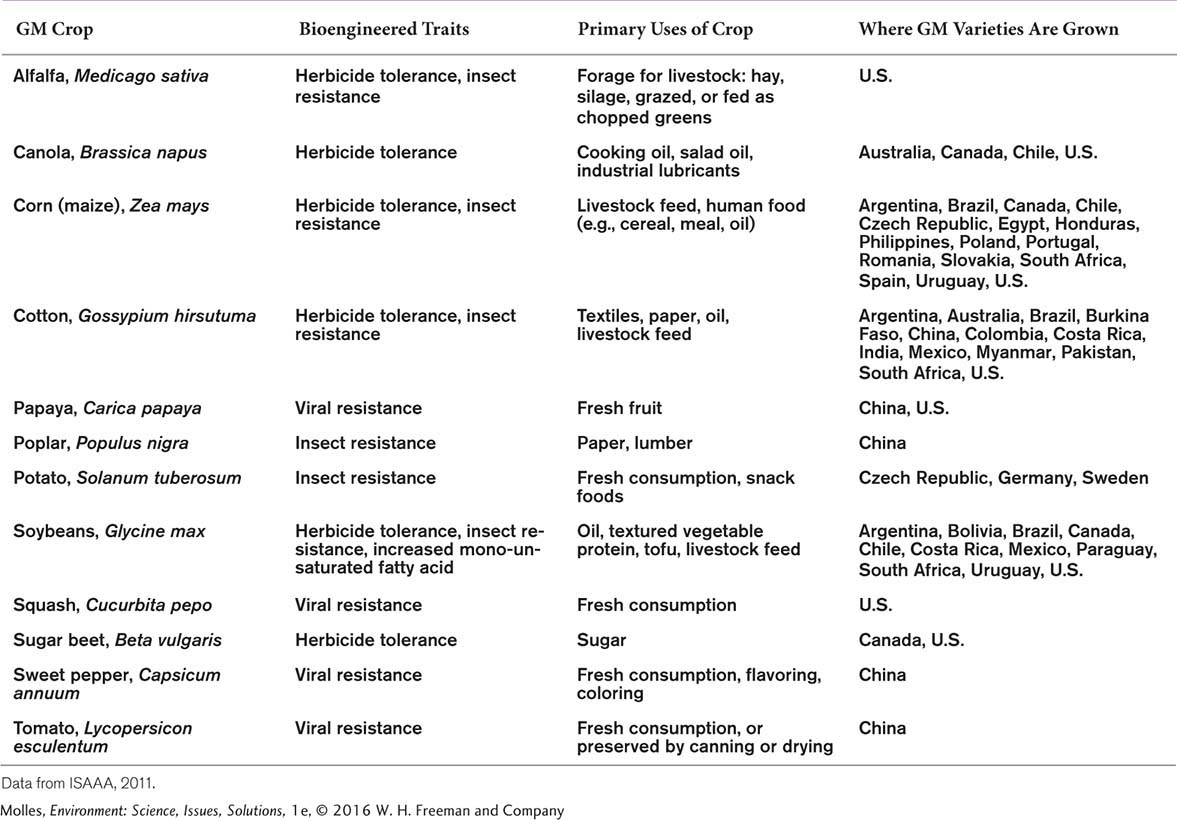7.9 Genetically modified crops are sources of controversy and agricultural potential
biotechnology The application of engineering techniques to modify organisms genetically for a particular purpose.
genetically modified (GM) organism (GMO) An organism into which one or more genes have been incorporated using the techniques of biotechnology.
The pace of developing new varieties of plants and animals has quickened with the arrival of biotechnology. Biotechnology uses engineering techniques to modify organisms genetically for a particular purpose, ranging from producing varieties that provide a more dependable source of medicines to devising crops that are more nutritious. A genetically modified (GM) organism, or GMO, has one or more new genes introduced into its genetic makeup by biotechnology, using an array of engineering methods.
transgenic organism A GM organism that contains genes from another species.
When the new genes come from other species, as is generally the case, GMOs are called transgenic organisms. For example, genes from the bacterium Bacillus thuringiensis have been inserted into the DNA of several crops, including corn, to increase the corn plant’s resistance to insects who chew on the plants.
Bt Insect-
In this process, a gene from B. thuringiensis, which codes for the insect-

Status of GM Crops
Most commercially grown GM crops have been engineered with three traits in mind: (1) the capacity to produce insect-
The United States leads the world in the adoption of GM crops. For example, we grow more GM crops than in any other nation (see Table 7.1). Also, in 2010, farmers in the United States planted nearly 67 million hectares (165 million acres) in GM crops, dwarfing the plantings in other nations (Figure 7.29). In addition, U.S. farmers show a high level of acceptance of GM crop varieties. According to the U.S. Department of Agriculture, by 2010, most of the corn (86%), cotton (93%), and soybeans (93%) grown in the United States were GM varieties. However, more and more farmers outside the United States are also adopting these GM varieties.

Why do you think the United States grows and consumes so many more GM crops than the rest of the world?

GM Crops: The Potential and the Controversy
Scientists are now developing many other GM crops, with traits including greater drought tolerance, improved storage potential, and better nutritional quality. One of the best-

In addition to improved nutrition, proponents of GM crops indicate several ways in which they benefit the environment. A 2010 U.S. National Academy of Sciences study reports that insecticide use has decreased with increased planting of Bt corn and cotton. Herbicide-
On the other hand, skeptics of GM crops have identified several areas of serious concern. Pest and weed populations have developed resistance to Bt toxins and herbicides through natural selection. If the genes that confer herbicide resistance are transferred to weeds, they may become more difficult to control or may spread to non-
Use of herbicide-

Should foods containing GM ingredients be labeled? What are the arguments for and against such labeling?
Critics also worry that the widespread adoption of GM crops will take control of food production away from individual farmers and place it in the hands of a few biotechnology companies. They are concerned over the implications of this control to food security, food prices, and the economic welfare and independence of farmers.
Many consumers are concerned that GM foods may be harmful to human health. Although scientific reviews of GM crops have found no evidence that that they are unsafe, opponents of GM crops argue that there has been insufficient testing and that much of the testing has been done by industry researchers. They worry that conflicts of interest may compromise some of the research findings.

What can be done to reduce the polarization between supporters and critics of using GM crops in agriculture?
The development of GM crops has also raised philosophical issues. Some opponents of biotechnology argue that the blending of genes from different species is “unnatural,” creating so-
Some consumer advocates argue that labeling food made with GM crops, such as corn chips or soy oil, could be a way to move forward. For example, the European Union follows a mandatory labeling policy, whereby any food containing 0.9% or more GM ingredients must be labeled accordingly. And multiple polls have shown that over 80% of U.S. consumers favor labeling of GM foods as well. In the United States, however, the two responsible agencies, the U.S. Food and Drug Administration and the U.S. Department of Agriculture, do not support mandatory labeling of GM food because it implies that these products are nutritionally different from non-
Still, U.S. consumers can avoid GM products at present (2015) by purchasing foods labeled as organic. As the controversy over GM crops continues (Figure 7.31), many food producers have begun labeling their products as GM-

Think About It
What roles should environmental impact, human health, and economics play in the criteria for approving GM crops for commercial release?
Some argue that the developers of GM crops should bear the costs of testing their safety; others argue that independent laboratories funded by government regulatory agencies should conduct such research. What is your position regarding this research and why?
What are the pros and cons of approving golden rice for planting and human consumption?
7.5–7.9 Issues: Summary
Reduction in soil fertility is one of today’s major global environmental concerns. Erosion is accelerated as farming of crops, livestock grazing, and forestry reduce plant cover and physically disturb topsoil. Continuous harvesting of crops and forests depletes soil nutrients in many regions, particularly in developing countries.
The world’s forests are disappearing at a startling rate in order to provide wood products and farmland for the growing population. This increases erosion, contaminates freshwater quality, and threatens biodiversity. Different techniques for forest management, such as clear-
Irrigation increases the productivity of farmlands—
The social and environmental costs of pesticides applied in the United States approximately equal their purchase price. In addition, intensive agriculture often creates environmental conditions that favor outbreaks of crop pests and the evolution of pesticide resistance. GM crops have been engineered to produce insect-
